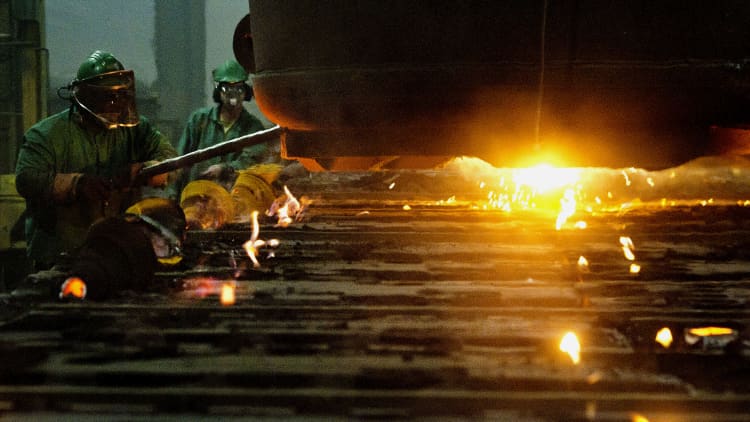
First quarter growth slipped to the weakest quarterly pace in three years, but inflation and wages picked up, signaling the Fed will press ahead with interest rate hikes.
Growth in gross domestic product was reported at a seasonally adjusted 0.7 percent, below the 1.2 percent in the Thomson Reuters consensus forecast. It was also below the CNBC/Moody's Analytics Rapid Update tracking rate, updated Thursday to just 0.8 percent, the same as first quarter last year.
But the rate of inflation, measured by the personal consumption expenditures price index, rose at a rate of 2.4 percent, the biggest jump since 2011.
Peter Boockvar, chief market analyst with Lindsey Group, points out that the employment cost index, another early indicator for inflation, also rose 0.8 percent quarter over quarter, 0.2
"This brings the [year-over-year] gain to 2.4 percent which is the best in two years. Specifically, private sector wages and salaries were up by 2.6 percent [year over year] which matches a two-year high. Bottom line, the ever elusive evidence of rising wages might finally be peaking its head above water,"
There were some troubling signs in the GDP report but economists are so far writing them off as temporary and expect a bounce back in the second quarter. The report does follow a string of weaker-than-expected reports, including CPI, jobs and retail sales.
"The Q1 conundrum strikes again. It's not a good number. The swing factor tends to be net exports, and inventories once again were
The report shows the impact of a sharp cutback in purchases of autos and durable goods. Consumer spending rose just 0.3 percent, the weakest since 2009, but it follows several strong quarters.
"We've been here before
First quarter growth has a track record of being weak, and economists say the government is working to straighten out the quirks that have plagued its calculations for at least two decades. There were also some specific factors at play, such as very warm weather in January and February but winter storms in March.
"The inflation numbers accelerated, but they still remain moderate. It supports the contention that the Fed is attaining its objective on the inflation side," said McCarthy. The Fed has targeted 2 percent inflation. McCarthy said the report suggest the Fed should continue on its rate hiking path. It has forecast two more rate hikes this year, though it is not expected to raise rates when it meets next week.
The concern would be if growth remained sluggish, but the Fed were forced to move ahead with rate hikes because of rising inflation. Economists, however, see an improvement in the second quarter, with some forecasting growth at 3 percent or higher.
Stocks opened higher Friday but slipped into slightly negative territory. Treasurys were weaker, and yields, which move inversely to prices, were higher.
In a positive sign, business spending picked up on long-term projects. Nonresidential fixed investment grew at 9.4 percent, the largest gain since 2013.


